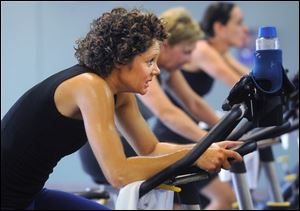
Exercise can help people with diabetes profoundly reduce medication
11/25/2013
The weight loss that exercise helps hasten is a major driver of health improvements, particularly for Type 2 diabetics.
CHICAGO — When Jay Smith fell off his jogging routine, he gained 25 pounds and saw his average blood sugar level climb into dangerous territory.
So Smith, a 48-year-old Type 1 diabetic, did what many people do when they need to get in shape: He began a diet and workout regimen. But while exercise benefits everyone, diabetics in particular can see dramatic improvements in their health.
After completing the 12-week Weight Achievement and Intensive Treatment (Why WAIT) fitness program at the Boston-based Joslin Diabetes Center, Smith lost the 25 pounds and saw his hemoglobin A1C level, a measurement that reflects a person’s average blood sugar level over several months, drop from 8 percent to 5.8 percent (7 percent or less is a common treatment target for diabetics). He also has been able to cut his insulin intake in half and reduce his cholesterol and blood pressure medications.
“Diabetics should consider exercise as a prescription; it is cheap and extremely effective,” said Dr. Osama Hamdy, medical director of the Obesity Clinical Program at Joslin, a research and clinical care center affiliated with Harvard Medical School. Hamdy also co-wrote The Diabetes Breakthrough, an upcoming book about the Why WAIT program, slated for March publication.
The weight loss that exercise helps hasten is a major driver of health improvements, particularly for Type 2 diabetics, who often struggle with obesity and constitute about 90 percent of the country’s 23.6 million diabetics. Hamdy’s research on the Why WAIT program found that when obese Type 2 diabetics lost 7 percent of their body weight, their insulin sensitivity improved by 57 percent, equivalent to taking two medications. Eighty-two percent of the participants were able to reduce their medication by 50 to 60 percent.
His results mirrored an earlier major study of prediabetics, who are at greater risk of developing Type 2 diabetes because their blood glucose levels are higher than normal. That study found that doing 30 minutes of physical activity five days a week reduced the five-year risk of getting diabetes by 58 percent. That was more effective than taking the common antidiabetic drug metformin, which reduced diabetes incidence by 31 percent, according to the study, published in 2002 in the New England Journal of Medicine. The Department of Health and Human Services estimates that a quarter of U.S. adults 20 years or older, about 57 million people, had prediabetes in 2007.
Weight loss isn’t the only way exercise benefits diabetics. Exercise helps drive glucose out of the bloodstream and into cells, where it’s used for fuel, making diabetics less dependent on insulin to process their meals, said Dr. John Anderson, president of medicine and science at the American Diabetes Association. Strength training, even more than cardiovascular exercise, lowers blood sugar levels for a longer duration, he said.
Strength training also helps build muscle mass, which is particularly important for diabetics, Hamdy said. Everyone loses muscle mass as they age, but diabetics lose muscle faster, perhaps because of metabolic abnormalities, he said. The quadricep muscles in the thighs are particularly vulnerable.
Strength training is a must for diabetics who are dieting, Hamdy said. Dieting accelerates the loss of muscle mass because people consume less protein, which in turn decreases basal metabolic rate and makes it harder to lose weight or sustain weight loss. When people lose weight just from dieting, 27 percent of weight loss is from muscle mass, Hamdy said. If you add more protein and strength training, muscle mass loss drops to 10 percent of weight loss, helping to maintain the basal metabolic rate.
Hamdy said 300 minutes of activity per week is ideal for diabetics to obtain and maintain good weight loss, incorporating a combination of aerobic exercises, flexibility and, most important, strength training. Beginners can start with 20 to 30 minutes three times a week and build up slowly.
Because exercise lowers blood sugar levels, there is the risk of hypoglycemia. Diabetics must plan accordingly and learn to recognize the symptoms, which vary but often include sweating, nervousness, jitteriness, hunger and lightheadedness, Anderson said.
Type 1 diabetics, who produce no or very little insulin, and some Type 2 diabetics who take insulin should be vigilant about monitoring their blood sugar levels before and during workouts so that they know how much insulin they need, Anderson said. He also advises they carry a carbohydrate source, like fruit juice or glucose tablets, during workouts in case their blood sugar dips too low.
Blair Ryan, 27, who was diagnosed with Type 1 diabetes when she was in high school, last year completed an Ironman triathlon (2.4 miles of swimming, 112 miles of cycling and a 26.2-mile run) in Tempe, Ariz.
Ryan, who works at Insulindependence, a San Diego-based nonprofit that promotes recreation for people with diabetes, said the most challenging part of being a diabetic athlete is figuring out her insulin strategy so that she doesn’t take too much before a workout, when the exercise brings her blood sugar down, or too little before a race, when adrenaline pushes her blood sugar higher.
Ryan wore a continuous glucose monitor during the Ironman and, to back up that data, pricked her finger at each of the transition points to check her blood sugar on a glucometer. She worried that the units of insulin she took before jumping in the pool at the starting line were bringing her blood sugar levels too low, so she forced herself to eat carbs during the race.
Ryan finished in 11 hours and 40 minutes, beating her 12-hour goal. “I had a great day, and although I stepped on the starting line undertrained, I learned that a lifetime of endurance athletics, having a solid insulin and nutrition strategy, and support from friends and family goes a long way,” she said.